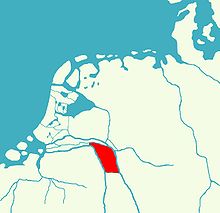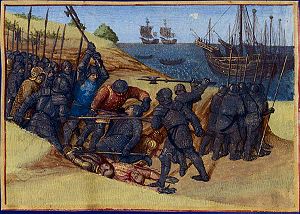- Hygelac
-
 Hettergouw at the lower Rhine, inhabited by the Attoarii or the Hetware, who killed Hygelac according to Beowulf, line 2916.
Hettergouw at the lower Rhine, inhabited by the Attoarii or the Hetware, who killed Hygelac according to Beowulf, line 2916.
Hygelac (Old English: Hygelāc; Old Norse: Hugleikr; Proto-Germanic: *Hugilaikaz;[1] Latin: Chlochilaicus; died c. 521) was a king of the Geats according to the poem Beowulf. He was the son of Hrethel and had brothers Herebeald and Hæthcyn. His sister was married to Ecgtheow and had the son Beowulf. Hygelac was married to Hygd and they had the son Heardred, and an unnamed daughter who married Eofor. When Hygelac's brother Hæthcyn was fighting with the Swedes, Hygelac arrived one day too late at Hrefnesholt to save his brother, but managed to rescue the surviving Geatish warriors, who were besieged by the Swedish king Ongentheow. The Swedes found refuge at a hill fort but were assaulted by the Geats and the Swedish king was slain by Eofor. After the death of his brother, Hygelac ascended the Geatish throne. Hygelac then went on a Viking raid to Frisia and was killed. Hygelac was succeeded by Heardred, according to Beowulf.
The raid to Frisia enabled N. F. S. Grundtvig[2] to approximate the date of Hygelac's death to ca 516, because a raid to France under a King Chlochilaicus, king of the Danes is mentioned by Gregory of Tours. In these sources he appears as invading the Frankish Kingdoms during the reign of Theuderic I in the early sixth century, and was killed by a military force led by Theudebert, son of the king of the Franks. Gregory of Tours calls this king Danish.[3] He is called the king of the Getae in the Liber Monstrorum (rex Getarum) and of the Goths in Liber historiae Francorum (rege Gotorum).[4]
There are two theories on how the account of Chlochilaicus' raid came to be preserved in the epic Beowulf, and they have a bearing upon the date assigned to the poem. It may date to the early 8th century, but some have suggested that it was composed as late as the 10th century.[5] One view considers the account to have kept alive by the oral tradition of heroic poetry until it was included in the epos.[5] It has also been suggested that the poem is dependent on Liber historiae Francorum (727), because it mentions the Attoarii, which in Beowulf become Hetware. One scholar considers it to be inconceivable that independent oral tradition would have faithfully transmitted such a detail.[6] Walter Goffart estimated that Beowulf could not have been written with these historical details before 923.[7]
Hreðel | --------------------------------------------- | | | | Herebeald Hæþcyn Hygelac daughter Ecgþeow | | | | ---------------- Hygd | | | | Beowulf -------------- | -------------- | | Heardred daughter Eofor | | --------------Preceded by
Hæthcyn(legendary) Succeeded by
HeardredSources and notes
- ^ Peterson, Lena (2007). "Lexikon över urnordiska personnamn". Swedish Institute for Language and Folklore. pp. p.39. http://www.sofi.se/images/NA/pdf/urnord.pdf. (Lexicon of nordic personal names before the 8th century); from hyg "courage" and -lac.
- ^ Grundtvig produced the first translation of Beowulf into a modern language, Bjovulfs Drape (1820).
- ^ Gregory of Tours, Decem Libri Historiarum III 3, http://www.thelatinlibrary.com/gregorytours/gregorytours3.shtml at The Latin Library
- ^ All three sources in Latin and in English translation
- ^ a b The Norton Anthology of English Literature (1986). W. W. Norton and Co., Ltd, 1986:19. ISBN 0393954722.
- ^ Weibull, C.H.J. (1974), Die Geaten des Beowulfepos, pp. 24, ISBN 9185252026
- ^ Johnston Staver, Ruth (2005), "Placing Beowulf on a Timeline.", A Companion To Beowulf, pp. 135, ISBN 031333224X
Further reading
- G. Storms, "The Significance of Hygelac's Raid" in Nottingham Mediaeval Studies", 14 (1970:3-26).
See also
Beowulf Characters 
Scholars
TranslatorsDepictions Books- Grendel
- Eaters of the Dead
- The Legacy of Heorot
- Beowulf's Children
- Beyond Beowulf
FilmSee also - Anglo-Saxon paganism
- Battle of Finnsburg
- "Beowulf: The Monsters and the Critics"
- Heorot
- Hrunting
- Nægling
- Nowell Codex
Categories:- Characters in Beowulf
- English heroic legends
- Kings of the Geats
- 6th-century monarchs in Europe
Wikimedia Foundation. 2010.

